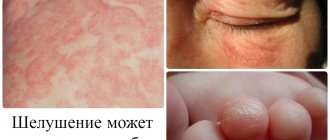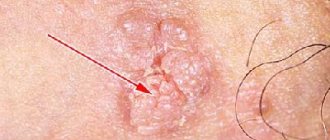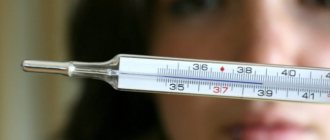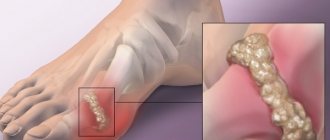Causes of frostbite and their nature
Frostbite is a cold injury; its peculiarity is that it is likely to occur not only at sub-zero ambient temperatures, but also when a person spends a long time outdoors at a temperature of +4..+8°C.
Changes in tissues occur not only under the influence of low air temperature, but also under the local action of ice, snow, cold metal products or water.
The development of frostbite begins with pathological changes in the blood vessels. Then circulatory disorders occur, which entail degenerative changes in the cells of the body; secondary tissue necrosis develops. Most often the face, limbs (fingers), and ears are affected. Frostbite in other parts of the body is rare, usually with general freezing, when profound changes are observed in all tissues, blood circulation stops and anemia of the brain occurs.
The development of frostbite is promoted by:
- General exhaustion of the body, vitamin deficiency.
- Elderly age.
- Vascular diseases and circulatory disorders.
- Strong wind.
- High air humidity, damp clothes.
- Alcohol intoxication.
- Drowsiness.
- Incorrectly selected clothes and shoes.
- Limb injuries.
How many degrees of frostbite are there and their signs?
Frostbite is tissue damage caused by exposure to low temperatures. Frostbite is classified according to degrees - from first to fourth, depending on the depth of the lesion.
Most often, frostbite occurs in the cold winter when the ambient temperature is below minus 10 °C. If you stay outdoors for a long time, especially in high humidity and strong winds, frostbite can occur in the fall and spring when the air temperature is above zero. Fingers, toes, nose, ears and face are more susceptible to frostbite. The severity of frostbite depends on the duration of the cold, as well as on the condition of the body.
Factors predisposing to frostbite are a general weakening of the body due to blood loss, fasting, vitamin deficiency, diseases of the cardiovascular system, and fatigue.
In this section of the article you will learn about the classification of frostbite by degree and first aid depending on the depth of tissue damage.
So, how many degrees of frostbite are there, and what are the signs of damage at each stage?
There are 4 degrees of frostbite:
- Frostbite of the first degree develops after short-term exposure to cold. The victim's skin is pale in color and somewhat swollen. Another sign of first-degree frostbite is a sharp decrease in skin sensitivity or its complete absence. After warming, the skin acquires a blue-red color, swelling intensifies, and dull pain is often observed. There is no dead skin. 7 days after frostbite, slight peeling of the skin is sometimes observed. Full recovery occurs 5-7 days after frostbite.
- Second degree frostbite occurs with prolonged exposure to cold. When warming up, the pale skin of the victim acquires a purplish-bluish color, and tissue swelling quickly develops, spreading beyond frostbite. In the first days after injury, blisters filled with transparent contents form. Complete restoration of the integrity of the skin occurs within 1-2 weeks, granulations and scars are not formed. Impairment of skin sensitivity may persist for a long time, but at the same time significant pain is noted.
- Frostbite of the third degree is observed with prolonged exposure to cold. In this case, the bubbles appear early, they are filled with bloody contents, their bottom is blue-purple. Another sign of third-degree frostbite is insensitivity to irritations. The death of all skin elements occurs with the development of granulations and scars as a result of frostbite. Fallen nails do not grow back or grow deformed. Damage to deep tissues is detected after 3-5 days in the form of developing wet gangrene. The intensity and duration of pain is more pronounced than with frostbite of the second degree. Intoxication is manifested by tremendous chills and sweats, a significant deterioration in well-being, and apathy.
- IV degree frostbite occurs with prolonged exposure to cold. It is characterized by necrosis of all layers of skin, underlying tissues, bones and joints. It is often combined with frostbite of the third and even second degree. The damaged area of the limb is sharply bluish, sometimes with a marble coloring. Swelling develops immediately after warming and increases rapidly. The skin temperature is significantly lower than the tissue surrounding the frostbite area. Bubbles develop in less frostbitten areas where there is frostbite of the III-II degree. The damage border appears slowly, a distinct line is revealed after 10-17 days. The damaged area quickly turns black and begins to dry out. The process of rejection of a necrotic limb lasts about 1.5-2 months.
Photos of frostbite of all degrees are presented on this page:
Symptoms of frostbite
Symptoms differ depending on the period of frostbite:
- Before warming up (pre-reactive period) - at this time a tingling and burning sensation is felt in the affected areas of the body. The feeling of cold is gradually replaced by loss of sensitivity. The skin at the site of frostbite becomes pale, with a bluish tint. The limbs stop moving and “turn to stone.”
- After warming up (reactive period) , the affected area becomes painful and swelling develops. Subsequently, inflammation and signs of tissue death appear.
Immediately after warming the frostbitten area, it is impossible to determine the severity of the lesion; sometimes the picture becomes clear after a few days. There is a classification of frostbite based on the depth of penetration of cold damage into the tissue.
Reasons for development
Various factors can provoke a decrease in body temperature, both general and local.
All of them are associated with exposure to low temperatures, but most often first-degree frostbite is provoked by the following reasons:
- Adverse weather conditions. At temperatures from -10 to -20, such injuries occur most often. If there is strong wind or high humidity, frostbite can occur even at an ambient temperature of +1-0 degrees.
- Tight shoes. The lack of a high-quality insole and squeezing the foot leads to increased humidity inside the shoe. A person cannot move his fingers, and in addition, blood circulation may be impaired.
- The presence of exposed or insufficiently insulated parts of the body. You should not go outside in the cold without gloves, with insufficiently insulated feet, without a hat and scarf.
- Contact with cold objects. Prolonged contact with snow, ice, and cold objects provokes intense heat loss in tissues. Wearing metal accessories also increases the likelihood of developing frostbite.
- Prolonged immobilization. If you don't move your fingers for a long time, they will freeze much faster. Keeping a person motionless slows down the production of internal heat while simultaneously releasing it.
If the influence of these factors is not eliminated, body temperature will decrease, which will lead to an exacerbation of the problem and general hypothermia.
Characteristic symptoms
Some people who are faced with a similar problem do not attach much importance to the symptoms that arise and do not even suspect that it is frostbite. If you continue to ignore the discomfort, the situation will worsen and deeper layers of tissue will be affected.
Stage 1 frostbite manifests itself as follows:
- local blanching of the skin;
- a significant decrease in sensitivity in the affected areas;
- slight tingling sensation that intensifies as you warm up;
- after moving to a warm place, the skin turns red;
- slight swelling may occur;
- burning;
- specific itching;
- later flaky areas of skin form.
The symptoms do not cause much discomfort and do not affect a person’s performance. They quickly disappear, leaving no traces on the body. Absolutely all processes that occurred in supercooled areas are completely reversible, and there is no serious threat to the health of the victim.
Further consequences
If the factor that provokes hypothermia is not eliminated in a timely manner, complications can arise. In severe cases, the price for neglect of one's health is the loss of frostbitten body parts. For a first-degree injury, there are no such risks, but some complications may still arise.
Negative consequences may include:
- frostbite of 2 - 3 degrees with continued exposure to low temperatures;
- general hypothermia of the body is mild or moderate;
- development of colds;
- the occurrence of skin problems in the freezing area;
- infection gets into microcracks in the skin.
Important! You should not rub your skin with snow to avoid such consequences, as this measure will only aggravate the situation and lead to damage to small vessels.
Degrees of frostbite
- 1st degree – there is a circulatory disorder without tissue death. All violations are reversible. Patients feel pain, a burning sensation in the affected area, then sensitivity to external stimuli disappears. After warming up, the skin turns red and swelling appears. These phenomena go away on their own after a few days, the skin peels off and then takes on its normal appearance.
- 2nd degree – tissue nutrition is disrupted, blisters with light contents appear inside, and an infection may develop. Tissue functions are restored within a week, sometimes it takes longer.
- The 3rd degree of frostbite is characterized by the appearance of blisters filled with blood. The epithelium completely dies, patients experience severe pain. Gangrene develops - tissue death with the spread of infection to large areas of the body. Dead tissue is rejected within two to three weeks, healing occurs slowly, with the formation of scars and cicatrices.
- With the 4th degree of frostbite, necrosis occurs not only of soft tissues, but also of bones. The limbs become covered with dark blisters, pain is not felt, the fingers become black and mummify. Starting from the ninth day after frostbite, a granulation shaft appears - a line separating living and dead tissue. Rejection of dead areas and scarring occurs slowly, over two months. This degree is characterized by the frequent addition of erysipelas, sepsis, and osteomyelitis.
Consequences of frostbite
Frostbite, especially grade 3-4, carries enormous risks for the health and life of the patient, especially if he was not provided with timely, high-quality first aid and subsequent professional treatment.
- Persistent circulatory disorders;
- Partial or complete destruction of the skin, with the formation of scars and granulations, requiring plastic surgery;
- Systemic bacterial infections of the secondary type;
- Kidney failure;
- Liver failure;
- The development of gangrene, especially with degree 4 frostbite, in the vast majority of cases requiring amputation of a body part;
- Generalized blood sepsis caused by the entry into the bloodstream of products of irreversible decay of necrotic tissue;
- Death as a result of advanced, untreated forms of frostbite, or being in the cold for too long without transporting the victim to comfortable conditions.
First aid for frostbite
First aid to victims of frostbite occurs in the pre-reactive period, that is, before warming up. It includes the following activities:
- Warming the patient and his affected limbs.
- Restoring blood circulation in frostbitten areas of the body.
- Artificial respiration or administration of drugs to restore breathing (if necessary). If necessary, call an ambulance.
- Protection against infection through affected areas.
- Inside - hot drinks (tea, coffee), cardiac medications.
- Taking foot baths with a gradual increase in temperature from +18°C to +37°C.
- Light massage of the limbs.
- If signs of blood circulation appear (redness of the skin, increased body temperature), massage and warming are stopped, the affected areas are wiped with alcohol and an aseptic bandage is applied.
Signs of frostbite
In the first hours after injury, it is not possible to determine the extent of the damage. The fact is that the initial manifestations of injury are similar in all cases. Only after some time the symptoms depend on the depth of the pathological process and the degree of damage.
First of all, you should understand that in most cases the fingers or toes and face are affected and examine them carefully. If a child is playing on a slide and comes home with wet clothes, his skin should be checked to exclude the possibility of frostbite.
Signs indicating frostbite:
- redness/blueness of the skin (at first the frozen tissues turn pale or become cyanotic, then turn red due to the dilation of blood vessels);
- the presence of blisters (if the vascular wall is damaged, blood plasma penetrates the subcutaneous tissue, which leads to the formation of fluid-filled blisters);
- development of edema;
- tingling, and then partial or complete loss of sensitivity (appears as a result of disruption of the nerve endings); if frostbite is superficial, sensitivity is restored immediately after warming up;
- chills, “goosebumps” all over the body;
- peeling of the skin (sometimes);
- pain in the affected area (the intensity of the pain depends on the extent of the lesion).
Severe frostbite causes the skin to become insensitive, warm to ambient temperature, and turn black. In this case, the patient will not benefit from conservative treatment methods. The only correct solution is excision of dead areas or amputation.
Iron frostbite is a cold injury caused by contact of warm skin with cold-hot metal. As a rule, inquisitive kids who lick the fence or the back of the carousel suffer. It also happens that having lost a mitten, a child grabs the metal part of the sled with his bare hand. The horror is that the tongue or hand instantly and tightly sticks to the metal.
Having no idea how to properly free the victim from his shackles, the frozen tongue or hand is torn off along with the skin. As a result, the child screams from unbearable pain, and the parents go crazy from the sight of his blood. Although such injuries are rarely deep, they require competent and urgent disinfection.
What not to do if you have frostbite
Do not rub frostbitten areas with snow, as it can cause infection through damaged skin; Rubbing in oils and fats is ineffective.
Also, avoid warming the extremities too quickly due to the risk of shock. This is explained by the fact that cold blood from a frostbitten limb, when suddenly warmed up, instantly enters the bloodstream; the temperature difference causes a drop in pressure and shock.
It would be a mistake to drink alcohol in the cold, since due to the dilation of blood vessels, heat is lost and the result is the opposite effect.
After providing first aid and warming the patient, you can begin to treat frostbite.
Causes
Mittens and a warm hat should not be neglected.
- Weather. You can get hurt if you wear uninsulated clothing in winter. This also threatens those who neglect mittens and a warm hat.
- Thermal insulation of limbs. Frostbite can be caused by clothing and shoes that tighten areas of the body and interfere with the normal flow of blood.
- General health. Often, trauma, long-term fasting, constant stress, and excessive blood loss disrupt regulatory processes in the body and increase a person’s vulnerability to cold. It is also dangerous for people who are intoxicated to be in the cold, because they cannot control their behavior and can fall asleep on the street in extreme cold, which they do not feel due to impaired consciousness. According to statistics, 90% of frostbite cases occur among people who are drunk.
- Problems with blood circulation. Chronic diseases such as atherosclerosis, heart failure, diabetes mellitus, and HIV infection contribute to frostbite. These diseases impair blood circulation, which increases the risk of hypothermia.
Treatment of frostbite
The choice of treatment method depends on the degree of frostbite; doctors recommend administering anti-tetanus serum for prophylactic purposes for frostbite of degrees 2–4.
For frostbite of the 1st degree, the affected areas are wiped with a solution of tannin or boric alcohol. Physiotherapy procedures are prescribed: darsonvalization, UHF therapy. It is possible to use ointments with antibiotics (levomekol, oflomelid).
For frostbite of the 2nd degree, the blisters that appear and the skin around them are treated with 70% ethyl alcohol. After opening the blisters, the epidermis is removed and an alcohol dressing is applied to the wound. For preventive purposes, the doctor may prescribe antibiotics.
Frostbite of the 3rd degree is accompanied by tissue necrosis, so surgical treatment is performed - removal of dead areas (necrectomy). Apply bandages with alcohol or hypertonic (10%) sodium chloride solution, and prescribe antibiotics.
For grade 4 frostbite, surgical methods such as necrectomy, necrotomy, and amputation are used.
General treatment for all types of frostbite includes:
- The use of sleeping pills and painkillers.
- Vitamin therapy.
- Enhanced nutrition.
- Prescribing antibiotics locally or orally.
- Taking angioprotectors, anticoagulants and vasodilators to improve blood circulation and prevent the formation of blood clots.
- Introduction of detoxification solutions to remove breakdown products from the blood.
- During the recovery period - courses of magnetic therapy, UHF, electrophoresis.
For mild frostbite, you can use the following recipes:
- Dilute a teaspoon of calendula tincture in 10 ml of water and apply as a compress.
- Use a decoction of potato peels to make baths for frostbitten hands or feet.
- Apply pieces of aloe leaf to the affected areas.
Advice: when warming up from frostbite, you need to drink a lot of hot, sweet liquid: a decoction of viburnum, chamomile, ginger; Regular tea will also work.
Injuries often occur in winter when curious children taste frozen metal objects: the tongue instantly freezes to the piece of iron. Confused, the parents literally tear the child’s tongue off the metal, although it is enough to pour warm water on the stuck area. If a shallow wound forms on the tongue, it should be washed with hydrogen peroxide and a sterile bandage applied until the bleeding stops. Usually small wounds on the tongue heal quickly; rinsing with chamomile or calendula decoctions will help speed up the process. If the child is severely injured, it is necessary to see a doctor.
First aid
Treatment is carried out at home.
First aid includes the following:
- Stop exposure to cold environments.
- Change of clothes. Changing clothes will speed up the recovery process.
- Warming the body in a warm room. You can take a bath, the temperature of which at first does not exceed 25-26°, and then gradually raise the temperature to the physiological level of 37°C.
- Drinking warm tea and food after a wet procedure.
- Relaxing in bed under a wool blanket.
Do not quickly and intensely heat the affected area. This damages the skin and small blood vessels. There is an erroneous practice of rubbing the frostbite with hands, woolen fabrics, alcohol or snow. The victim ultimately receives additional injury to the area, since such measures contribute to the formation of blood clots in the vessels. Only taking the right measures contributes to recovery in 5-6 days. Timely assistance with 1st degree frostbite prevents complications.
Prevention of frostbite
In frosty weather, you need to carefully prepare for going outside, especially if you have to stand for a long time at a bus stop or somewhere else.
- It is recommended to wear clothing consisting of several layers. It would be good if the sweaters were wool, creating an air layer.
- Shoes should be a size larger to accommodate warm insoles and thick wool socks.
- You need to remove metal jewelry before going out into the cold.
- It is also recommended to eat a hearty meal; food should be high in calories to provide the body with energy.
- You should not lubricate your face and hands with regular moisturizing creams; there are special protective compounds for applying to the skin before going out into the cold.
- In the cold, you need to move all the time, turn away from the wind, and at the first opportunity go into warm rooms (cafes, shops).
By following simple frostbite prevention measures, you can protect yourself and your family from the unpleasant consequences of exposure to low temperatures. Knowing simple first aid techniques for frostbite will help reduce the likelihood of complications in the event of an emergency.
- How to quickly heal a bruise
Why shouldn’t you rub frostbitten areas and how to avoid hypothermia?
To protect the body from hypothermia and frostbite, a number of preventive measures should be followed.
Experts recommend:
- Do not go outside after drinking alcohol.
- In severe frost, stay home. If this is not possible, take all safety measures and avoid being in the cold for a long time.
- Don't smoke in the cold.
- Don't go for a walk on an empty stomach. An exhausted body will not be able to fully produce heat.
- Do not wear clothes that are too tight. There must be air between the shirt and the warm jacket. It is better to use underwear made of cotton fabric, but not synthetic.
- Do not wear wet or tight shoes, wear clean wool socks. They absorb moisture better.
- Don't go out into the cold without mittens. Hands should always be protected.
- Rings, earrings and other metal jewelry are not recommended to be worn at temperatures of -30 degrees.
- In case of frost, use special protective creams. They will help mitigate the effects of cold air.
- When walking in a group, watch the faces of your comrades and be sure to take action at the first sign of frostbite.
- Hands should be warmed in the armpits, but without rubbing them or patting them together.
- Do not stay in the cold wind for a long time. This is what most often causes frostbite.
- Do not go outside with wet hair after a shower or bath.
If clothes are wet, they need to be removed and wrung out.
You should also not wear cold or wet shoes. In cases where there is no spare underwear, put it back on and do exercises so that the body does not cool down. Then urgently seek help from passersby or a medical facility.
Frostbite of any degree poses a certain danger to human life and health. Many people know what measures should be taken in case of frostbite, but not everyone can understand what is strictly prohibited from doing. Correctly provided medical care will help keep a person healthy and avoid serious consequences such as amputation of limbs as a result of frostbite.
Possible consequences
It is important to know what to do in case of severe frostbite, since such injuries often provoke the development of various complications. That is why medical assistance is required.
Most often, the victim runs the risk of encountering the following problems:
- Infection. Pathogenic microorganisms penetrate damaged skin, and a weakened body is less able to resist them.
- Scarring. Severe frostbite disrupts the tissue structure, so after the wounds heal, marks in the form of scars remain on the body.
- Impaired sensitivity. Cold damages nerve endings; restoring their functions is a complex and lengthy process. Full restoration of sensation in the affected areas of the body is not always possible.
- Necrosis. Tissue death occurs with severe frostbite. If you go to the hospital in a timely manner, this process can be stopped.
- Amputation. If necrosis progresses, doctors are forced to amputate the damaged areas.
- Inflammatory diseases of the body. Hypothermia can cause diseases such as meningitis, pneumonia, arthritis, etc.
You can get more useful information on the topic if you watch the video in this article.











